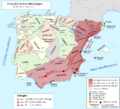Battle of Baecula facts for kids
Quick facts for kids Battle of Baecula |
|||||||
|---|---|---|---|---|---|---|---|
| Part of the Second Punic War | |||||||
 Roman conquest of Carthaginian Spain, 210–206 BC |
|||||||
|
|||||||
| Belligerents | |||||||
| Commanders and leaders | |||||||
| Scipio Africanus | Hasdrubal Barca | ||||||
| Strength | |||||||
|
40,000 30,000 Romans and Italians 10,000 Iberian |
30,000 | ||||||
| Casualties and losses | |||||||
| Unknown |
20,000 8,000 killed (Livy) 12,000 captured (Polybius) |
||||||
The Battle of Baecula was an important battle fought in ancient Spain during the Second Punic War. In this battle, the Roman army, led by Scipio Africanus, defeated the Carthaginian army, which was commanded by Hasdrubal Barca. This victory helped the Romans gain more control in Spain.
Contents
Why Did the Battle of Baecula Happen?
After Scipio made a surprise attack and captured Carthago Nova (a major Carthaginian city in Spain), the three Carthaginian armies in Spain were still separate. Their generals also disagreed with each other. This gave the Romans a good chance to fight them one by one.
In early 208 BC, Scipio moved his army to attack Hasdrubal Barca. Scipio had about 30,000 Roman and Italian soldiers. He also had 10,000 Spanish soldiers who helped him. Hasdrubal's army had about 30,000 soldiers. They had spent the winter near a town called Baecula, by the Baetis River (now called the Guadalquivir River).
When Hasdrubal learned that the Romans were coming, he moved his camp to a very strong defensive spot. This spot was a high, steep plateau south of Baecula. It was protected by deep ditches on its sides. The river was in front and behind it. The plateau also had two levels. Hasdrubal put his light troops on the lower level. His main camp was behind them.
When Scipio arrived, he wasn't sure how to attack such a strong position. But he was worried that the other two Carthaginian armies might join Hasdrubal. So, on the third day, Scipio decided to attack.
How the Battle of Baecula Was Fought
Before his main attack, Scipio sent two groups of soldiers. One group blocked the entrance to the valley between the two armies. The other group blocked the road leading north to Baecula. This protected Scipio's main army. It also made it harder for the Carthaginians to escape.
After these first moves, the Roman light troops attacked the Carthaginian light troops on the lower level of the plateau. Even though the slope was steep and arrows rained down, the Romans easily pushed back the Carthaginian light troops once they started fighting hand-to-hand.
Scipio then sent more soldiers to help his attacking force. He planned a "pincer attack" to hit the sides of the Carthaginian main camp. He ordered Gaius Laelius to lead half of the remaining heavy soldiers to the right side of the enemy. Scipio himself led the other half to climb the left side.
Meanwhile, Hasdrubal thought the Roman attack was just a small fight. Scipio had hidden his main army until the final attack. Because of this, Hasdrubal did not get his main army ready. His unprepared army was then attacked from three sides by the Romans.
Even though he was trapped, Hasdrubal managed to escape without much trouble. He took his war elephants, his main supplies, and some of his Carthaginian soldiers with him. It seems his biggest losses in the battle were most of his light troops and his Spanish allies. This happened because the Roman soldiers chose to take things from the Carthaginian camp instead of chasing Hasdrubal very hard.
What Happened After the Battle of Baecula?
After the battle, Hasdrubal led his smaller army away. This army was mostly made up of mercenaries from Spain and Gaul (modern-day France). He crossed the western Pyrenees mountains into Gaul. From there, he went into Italy. He hoped to join his brother, Hannibal.
The Roman Senate criticized Scipio for not stopping Hasdrubal's march to Italy. Scipio did not use his victory at Baecula to completely drive the Carthaginians out of Spain. Instead, he went back to his base at Tarraco. He made agreements with many Spanish tribes. These tribes switched sides and joined the Romans after the Roman victories at Carthago Nova and Baecula.
New Carthaginian soldiers arrived in Spain in 207 BC. They would soon try one last time to win back their losses at the Battle of Ilipa in 206 BC.
Images for kids
See also
 In Spanish: Batalla de Baecula para niños
In Spanish: Batalla de Baecula para niños


